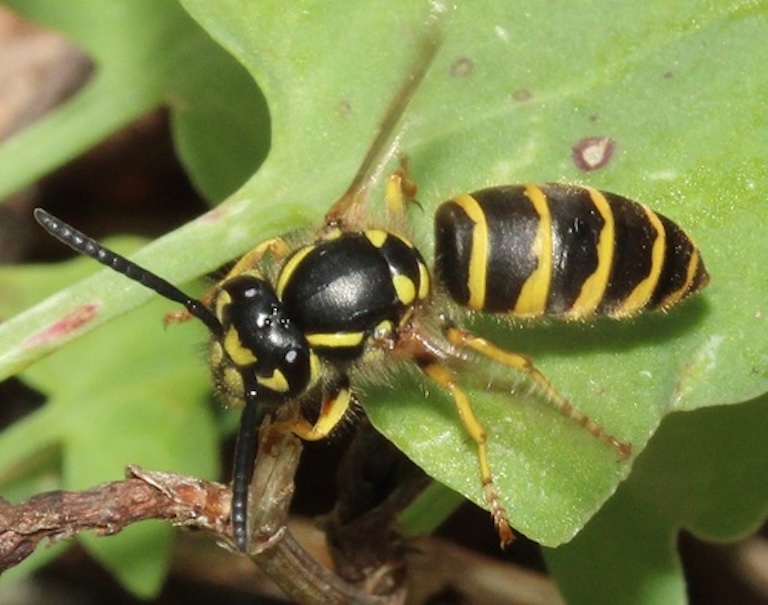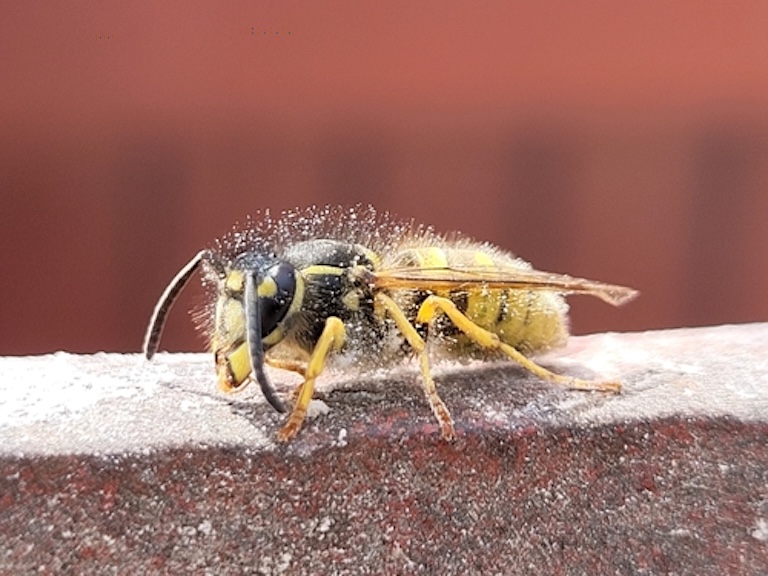Yellowjacket Profile
It’s Summer, and so all across Europe and North America, picnic goers are engaging in the age-old tradition of flapping about like an idiot because there’s a wasp nearby.
In the absence of any real danger, comfortable Westerners channel the full fury of their fight or flight instincts; 200,000 years of hard-wired paleo fear, evolved for short faced bears and cave hyenas, now focussed like a beam onto a small yellow insect that could really give you quite nasty sting.
But is there more to yellowjackets than the instant triggering of prehistoric generational trauma? We like to think so.

Yellowjackets Facts Overview
| Habitat: | Mostly temperate regions |
| Location: | North America, Eurasia, New Zealand, South America |
| Lifespan: | Usually 1 year |
| Size: | Up to around 2.5 cm (1 inch) long |
| Weight: | Up to around 60 mg |
| Color: | Black and yellow, sometimes red tones |
| Diet: | Invertebrates, nectar |
| Predators: | Birds, spiders |
| Top Speed: | Unknown |
| No. of Species: | More than 20 |
| Conservation Status: | Least Concern |
Far from being mindless killing machines, yellowjacket wasps are social, intelligent and valuable ecosystem servants who are mostly interested in foraging for nectar and looking after their babies. Just like we are!
While painful, their stings are simply a defense mechanism and only a serious issue in a miniscule minority of freak occurrences.
Despite being the most familiar type of wasp, Yellowjackets are unusual in their behaviours and represent an interesting and mysterious link between bees and ants that nobody’s quite figured out yet.
Interesting Yellowjacket Facts
1. They’re pretty ancient
Wasps, like spiders, are generally under-represented in zoology on account of most people finding them unpleasant. This is a real pity since both have roots that extend way back into prehistory and can tell us a lot about the world we’re living in now.
Yellowjackets are ancient, but still relatively recent arrivals, thought to have originated in the Mid-to-Late Cretaceous, but wasps as a whole date back to at least the Jurassic, and while their phylogeny is still a matter of contention, it’s thought that this group descended into bees and ants at different branches, later on. And because this group is paraphyletic, technically, then, ants are a group of wingless wasps, and bees probably are, too.
So, this is the first of many reasons not to decry wasps!

2. They’re eusocial
In nature, there are varying degrees of social behaviour. Some animals are totally not social, like monitor lizards, who lay their eggs and forget about them forever. Others, like crocodiles, help their babies along a bit by carrying them in and out of the water, and then go off alone later on. Some stay in small groups forever, others in larger groups, and some, still form such deeply social communities that their individualism is almost extinguished in favour of the “greater good” of their colony.
This last example is a form of called eusociality called reproductive altruism, and it’s what yellowjackets, honeybees and most ants exhibit. All three of which are in the same order of insect: Hymenoptera.
Yet, the origin of this behavioural strategy is a bit of a mystery. And strangely, it’s thought to have evolved independently within this order something like 8 to 11 times throughout history.
It shows up very rarely in almost all other animal orders, so there’s clearly something weird about ants, wasps and bees that predisposes them to evolve in this manner.
In yellowjackets, the queen hibernates through the winter while her entire colony dies off. In the Spring, she gathers nectar from flowers and starts building a new nest. To do this, she scrapes wood shavings from dry wood and mashes it into a pulp with saliva. This pulp is incredibly lightweight and strong, and responsible for the intricate waspy homes that we sometimes find to our dismay in the attic.
After 25 or so cells are made, she lays the first generation of her army into them. These sterile workers will take over the building duties while the queen focuses on producing copious amounts of offspring for the season.
Towards the end, the queen starts producing males and more queen cells, who will head out to mate and produce more nests. New queens will start their lives with a hibernation and old queens will usually only live one year and die after their first successful cycle. This is in contrast to bees and ants, whose queens can last many years, and so any yellowjacket nest you find will be far more temporary than an ant nest or beehive.
And this life cycle is fairly familiar to most of us, who learned it, or something very like it in primary school biology, yet it remains the outlier in the wasp world.

3. They’re unusual
Despite yellowjackets being basically what everybody means when they say “Wasp”, these eusocial varieties we’re most familiar make up just a tiny fraction of the 75,000 to 100,000 species of wasp all over the world, the vast majority of which are solitary parasitoid wasps.
So, the norm for wasps really is to paralyse something and lay its eggs in the victim’s living flesh, after which they hatch and eat around the vital organs, keeping their host alive as they’re slowly consumed by the larvae for sustenance.
This actually makes yellowjackets seem pretty tame, doesn’t it? Eusocial wasps like this are the weird ones, with paper wasps being the most common variety, at around 300 species, and yellowjackets making up around 23 species in all.
4. They’re adaptable
Most yellowjacket species are found in North America, but there are some really cool ones in Europe, too. Vespula rufa is a relatively docile species with smaller colonies that can live in far closer harmony with people on account of its more gentle nature. V. rufa can be safely kept by hobbyists and are also adorned with a nice red tint to their yellow jacket with makes them look awesome as well.
Ourside of North America and Europe, the genus has also spread more or less all over the world. South America, Asia, Australia and New Zealand all have species of their own, who have expanded out of their traditional ranges and into new habitats.
Some species have a more painful sting than other, such as V. germanica – the the larger of the European species, which does pack a punch, but no yellowjackets are really all that dangerous, nor are they aggressive when out foraging.
5. They are more defensive than bees
Like all eusocial animals, a yellowjacket’s primary concern is with the safety of its family. Unfortunately, human and wasp families often overlap, and this is where conflicts can arise. It’s not always easy to know where a wasp family is calling home until it’s too late, but the idea that wasps are psychotic rage machines just looking for a fight couldn’t be farther from the truth.
When out of the nest, wasps spend most of the day foraging, which is a state of relative calm, and as long as you don’t try to squash them, pick them up, or come close to their nest, they will be absolutely content to leave you alone.
If this is difficult to believe, just try to imagine the potential for reproductive success in an organism that just went about attacking everything all the time.
However, it’s important to notice that while a honeybee may instinctively refrain from self-defence up until the last minute, a wasp doesn’t risk leaving its sting inside its victim, so is more likely to be quicker on the draw.
Still, stings are almost always going to happen when you’re not paying attention.
6. If they were going to sting you, they would have already
If you are faced with a yellowjacket, buzzing about, checking you out, the time for flapping is already long gone. These are high performance aerial predators, they don’t require your permission or any choreographed, ceremonial duel to engage you in combat – they just do it. So, by the time you’ve seen them they’ve already determined that you’re not a threat.
They can, however, be curious animals, scanning you for food sources, or out of sheer fascination, so of course, waving your arms about frantically and screaming does increase the chances of them changing their mind about you, so it’s better to stay calm and walk the other way.
It’s can also very helpful to bat a wasp with the back of your hand to persuade it to leave. They have an infinite void of 3-dimensional space to escape into and will choose to do just that rather than getting angry, as long as they’re not cornered.
Panicking is generally how they get trapped in your shirt or between your skin folds and inevitably reinforce your phobia of them by stinging you.
And if the fear just isn’t subsiding, perhaps understanding their role in the ecosystem will help.
7. They’re Pollinators
Yellowjackets don’t store food in their nests like bees do, and they don’t collect pollen. But they do feed on nectar for their carbohydrate boost, and this brings them between flowers for most of the day. As such, they’re valuable pollinators, though not as effective as the hairier insects like honeybees.
Many wasp species are specialists that are responsible for pollinating much of the flowering fruit trees that we value, though yellowjackets tend to be more generalists in this regard.
While they do pollinate plants, their major role in the ecosystem is as pest control.

8. They’re Pest Control
Baby wasps need a lot of protein to grow, and this simply doesn’t come from nectar. Since pollen is hard to carry without the leg pouches that honeybees use, this protein comes from other insects.
As such, many yellowjacket species are top predators of all sorts of insects, and keep herbivores from spiralling out of control.
Vespula rufa, yet again, is remarkable in this regard, and one of the more predatory of the yellowjacket species.
So, overall, yellowjackets are far more of a help than a hindrance to humans. With the exception of the few that they kill.
9. They can kill you
At this point it would be a bit irresponsible to ignore the small potential for death that is present with wasp stings. For perspective, around 95% of people are sting by a bee or a wasp in their lifetimes, and, as you can see, most of them go on to live the same routine and uneventful lives working for The Man until they eventually die from something totally other.
Unfortunately, around 5% of them respond with some level of allergic reaction, and among that 5% around 10% of those become life threatening. Running the numbers, this means that around 0.005% of wasp stings can be life threatening. So that’s marginally above 0%, and just slightly less than the chances of being struck by lightning.
So, until we see the same people flapping their arms around during a thunderstorm, it’s safe to say this is more of an excuse than a genuine concern. 1
Yellowjacket Fact-File Summary
Scientific Classification
| Kingdom: | Animalia |
| Phylum: | Arthropoda |
| Class: | Insecta |
| Order: | Hymenoptera |
| Family: | Vespidae |
| Genus: | Vespula, sometimes also Dolichovespula. |
| Species Name: | 20+species |
Fact Sources & References
- Marszalska et al. (2015), “Insect sting allergy in adults: key messages for clinicians ”, National Library of Medicine.
